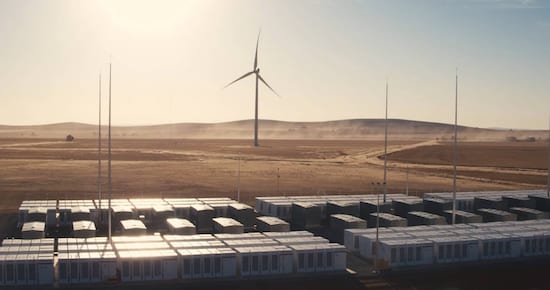The Australian Energy Market Operator has hailed the initial performance of the Tesla big battery in South Australia, saying the results of its first four months of operation shows it is faster and smarter than conventional turbines.
The 100MW/129MWh Tesla big battery, officially known as the Hornsdale Power Reserve, was officially switched on in December 1, with 70MW providing network security for the grid operator, and another 30MW operating energy arbitrage in wholesale markets.
How this battery’s abilities has been sliced and diced has been fascinating to the industry. Contrary to the constantly dismissive remarks of conservatives and the pro-coal lobby, it’s the performance of this battery that has impressed observers, including AEMO.
In a new report, the grid operator used these series of graphs below to illustrate how the battery was used in the frequency control and ancillary services market, providing a much more accurate response than conventional generators, and a much faster response.
The first illustration is the response to a major outage of a fossil fuel generator in NSW on December 18 (different to the one highlighted by RenewEconomy in Victoria on December 14, see our story Tesla big battery outsmarts lumbering coal units after Loy Yang trips).
The response of the Tesla big battery in the so-called “contingency FCAS market”, triggered when frequency deviates below 49.85Hz, was virtually immediate.
“Commissioning tests and simulations confirm that the HPR is capable of responding more rapidly to a contingency event than conventional synchronous generation,” AEMO notes in its report.
And the battery is significantly more accurate than conventional turbines.
These graphs published by AEMO indicate the response in the regulation FCAS market by both conventional steam turbine, and then by the Tesla big battery.
In the first graph, it shows the conventional turbine response to AEMO demands, in much the same way as a drunk may walk across the street, or throw darts at a dartboard.
The next graph shows the response of the Tesla big battery – a constant bullseye. “Experience shows that the HPR is capable of providing very high quality regulation FCAS,” AEMO notes.
Sadly, as Tesla has said on several occasions now, and as AEMO recognises in this report, there is actually no market in Australia for such speed and accuracy.
Even the conventional turbine staggering across its target range is operating within industry standards, but AEMO recognises that there could be a strong case for such markets to be developed, particularly as the grid changes to more inverter based technologies (wind and solar), and away from synchronous generation.
AEMO also notes the battery’s impact on the regulation FCAS market, which deals with slow moving frequency disturbances.
“This market has seen high prices for this service for the two years prior to the battery becoming operational,” AEMO notes. RenewEconomy has written more expansively on the battery’s ability to smash the gas cartel’s dominance of those FCAS markets.
So, not only is it faster and smarter, the battery storage technology also provides a cheaper outcome.
“This is the first time regulation FCAS has been provided in the NEM by any technology other than conventional synchronous generation,” AEMO notes, adding that the neighbouring Hornsdale Wind Farm has also recently trialled operation to provide regulation FCAS.
Remarkably, the bulk of the battery’s discharge capacity – 70MW – has not even been used yet. It is there sitting in reserve in an emergency – like the state government owned diesel gen-sets – but has not yet been called upon.
But its value is clear, and AEMO says it the battery will also be incorporated into a new control scheme – the System Integrity Protection Scheme (SIPS) – designed to stop the state separating from the main grid.
Its role will be to provide extra response in case of a major frequency disturbance, or a sudden surge on the interconnector – effectively holding the grid together while the remaining slow-moving conventional generators get into gear.
AEMO notes that future batteries may not have the same set-up as the Tesla big battery, because the needs in different parts of the grid are different.
“Operation of the HPR to date suggests that it can provide a range of valuable power system services, including rapid, accurate frequency response and control,” it writes.
“The funding arrangements for the HPR meant there was a focus on ensuring all its capabilities were fully utilised to maximise power system security for South Australia.
“This included engagement with AEMO when control settings and operating arrangements were determined, in a way that would not typically occur for other generation development (where the project developer is responding to existing market signals and arrangements).
“Future development of batteries outside of South Australia might not result in the provision of similar services, due to the way FCAS are currently quantified and rewarded, as well as the voluntary nature of participation in the FCAS market, and in frequency control arrangements more broadly.
“Where other large batteries are established under government incentive schemes, there could be a role for a more prescriptive provision of system security services, to maximise the benefits to the power system such devices can provide.
“Current FCAS market arrangements could also be modified to specifically recognise the rapid and accurate response capabilities of batteries, and therefore enhance their ability to earn income from providing them.”










